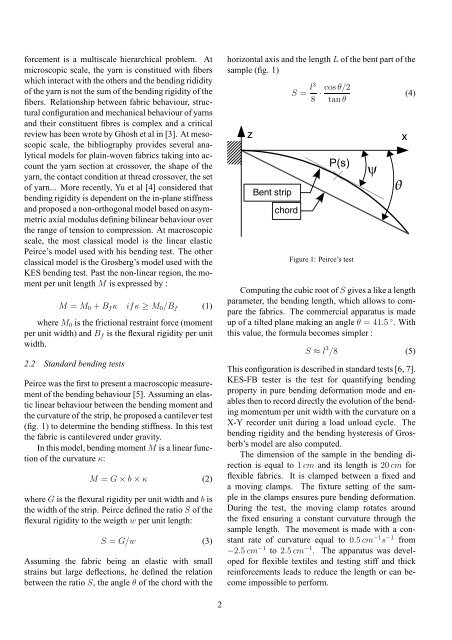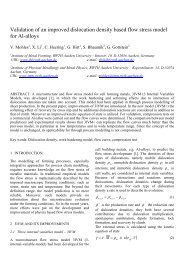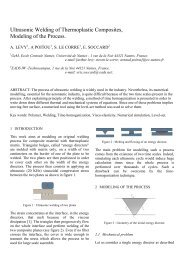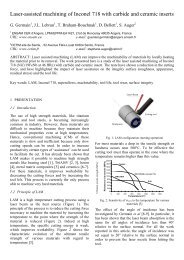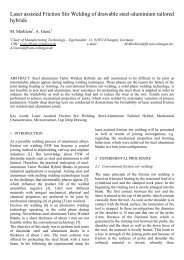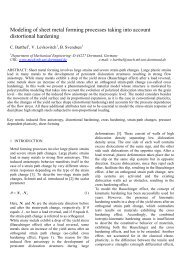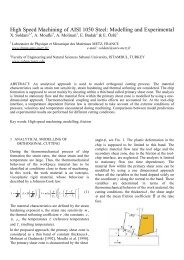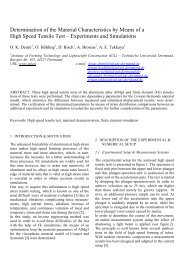bending test of composite reinforcements - ResearchGate
bending test of composite reinforcements - ResearchGate
bending test of composite reinforcements - ResearchGate
You also want an ePaper? Increase the reach of your titles
YUMPU automatically turns print PDFs into web optimized ePapers that Google loves.
forcement is a multiscale hierarchical problem. At<br />
microscopic scale, the yarn is constitued with fibers<br />
which interact with the others and the <strong>bending</strong> rididity<br />
<strong>of</strong> the yarn is not the sum <strong>of</strong> the <strong>bending</strong> rigidity <strong>of</strong> the<br />
fibers. Relationship between fabric behaviour, structural<br />
configuration and mechanical behaviour <strong>of</strong> yarns<br />
and their constituent fibres is complex and a critical<br />
review has been wrote by Ghosh et al in [3]. At mesoscopic<br />
scale, the bibliography provides several analytical<br />
models for plain-woven fabrics taking into account<br />
the yarn section at crossover, the shape <strong>of</strong> the<br />
yarn, the contact condition at thread crossover, the set<br />
<strong>of</strong> yarn... More recently, Yu et al [4] considered that<br />
<strong>bending</strong> rigidity is dependent on the in-plane stiffness<br />
and proposed a non-orthogonal model based on asymmetric<br />
axial modulus defining bilinear behaviour over<br />
the range <strong>of</strong> tension to compression. At macroscopic<br />
scale, the most classical model is the linear elastic<br />
Peirce’s model used with his <strong>bending</strong> <strong>test</strong>. The other<br />
classical model is the Grosberg’s model used with the<br />
KES <strong>bending</strong> <strong>test</strong>. Past the non-linear region, the moment<br />
per unit length M is expressed by :<br />
M = M 0 + B f κ ifκ ≥ M 0 /B f (1)<br />
where M 0 is the frictional restraint force (moment<br />
per unit width) and B f is the flexural rigidity per unit<br />
width.<br />
2.2 Standard <strong>bending</strong> <strong>test</strong>s<br />
Peirce was the first to present a macroscopic measurement<br />
<strong>of</strong> the <strong>bending</strong> behaviour [5]. Assuming an elastic<br />
linear behaviour between the <strong>bending</strong> moment and<br />
the curvature <strong>of</strong> the strip, he proposed a cantilever <strong>test</strong><br />
(fig. 1) to determine the <strong>bending</strong> stiffness. In this <strong>test</strong><br />
the fabric is cantilevered under gravity.<br />
In this model, <strong>bending</strong> moment M is a linear function<br />
<strong>of</strong> the curvature κ:<br />
M = G × b × κ (2)<br />
where G is the flexural rigidity per unit width and b is<br />
the width <strong>of</strong> the strip. Peirce defined the ratio S <strong>of</strong> the<br />
flexural rigidity to the weigth w per unit length:<br />
S = G/w (3)<br />
Assuming the fabric being an elastic with small<br />
strains but large deflections, he defined the relation<br />
between the ratio S, the angle θ <strong>of</strong> the chord with the<br />
horizontal axis and the length L <strong>of</strong> the bent part <strong>of</strong> the<br />
sample (fig. 1)<br />
S = l3 8<br />
· cos θ/2<br />
tanθ<br />
Figure 1: Peirce’s <strong>test</strong><br />
(4)<br />
Computing the cubic root <strong>of</strong> S gives a like a length<br />
parameter, the <strong>bending</strong> length, which allows to compare<br />
the fabrics. The commercial apparatus is made<br />
up <strong>of</strong> a tilted plane making an angle θ = 41.5 ◦ . With<br />
this value, the formula becomes simpler :<br />
S ≈ l 3 /8 (5)<br />
This configuration is described in standard <strong>test</strong>s [6, 7].<br />
KES-FB <strong>test</strong>er is the <strong>test</strong> for quantifying <strong>bending</strong><br />
property in pure <strong>bending</strong> deformation mode and enables<br />
then to record directly the evolution <strong>of</strong> the <strong>bending</strong><br />
momentum per unit width with the curvature on a<br />
X-Y recorder unit during a load unload cycle. The<br />
<strong>bending</strong> rigidity and the <strong>bending</strong> hysteresis <strong>of</strong> Grosberb’s<br />
model are also computed.<br />
The dimension <strong>of</strong> the sample in the <strong>bending</strong> direction<br />
is equal to 1 cm and its length is 20 cm for<br />
flexible fabrics. It is clamped between a fixed and<br />
a moving clamps. The fixture setting <strong>of</strong> the sample<br />
in the clamps ensures pure <strong>bending</strong> deformation.<br />
During the <strong>test</strong>, the moving clamp rotates around<br />
the fixed ensuring a constant curvature through the<br />
sample length. The movement is made with a constant<br />
rate <strong>of</strong> curvature equal to 0.5 cm −1 s −1 from<br />
−2.5 cm −1 to 2.5 cm −1 . The apparatus was developed<br />
for flexible textiles and <strong>test</strong>ing stiff and thick<br />
<strong>reinforcements</strong> leads to reduce the length or can become<br />
impossible to perform.<br />
2


